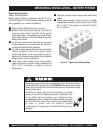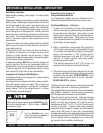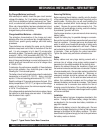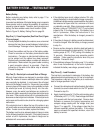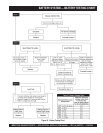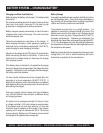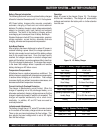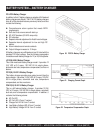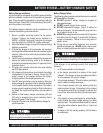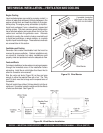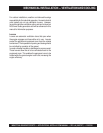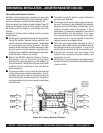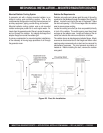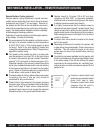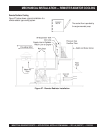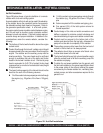
INDUSTRIAL GENERATOR SETS — APPLICATION & INSTALLATION MANUAL — REV. #4 (09/07/07) — PAGE 59
Battery Charger Safety
The following safety precautions should always be used with
MQ Power battery chargers.
z
DO NOT operate if battery charger is dropped or
otherwise damaged.
z
DO NOT expose charger to rain or snow.
z
DO NOT disassemble charger. Return to factory for
service and repairs. Incorrect assembly may result in a
risk of electric shock or fire.
z
ALWAYS de-energize and disconnect the AC input and
the battery from the charger if contact with the battery
charger is necessary. Failure to do so may result in
electric shock.
z
During normal operation, batteries may produce
explosive hydrogen gas. NEVER smoke, use an open
flame, or create sparks near the battery or charger.
If the charger is not working correctly, first check the
following:
1. Is AC power available to the charger?
2. Is the charger connected to a battery of the correct
voltage? (The charger must be connected to a battery
for it to operate at the correct voltage.)
3. Is the charger damaged? (Check for debris, particularly
metal, inside the charger enclosure.)
4. If the charger appears not to be working check the
battery's state of charge. If the battery is fully charged
it is sometimes normal for the charger to indicate zero
current flow. Also check the battery for shorted or open
cells.
5. If the battery is being overcharged or undercharged,
check whether the output voltage settings have been
tampered with. The potentiometers should be covered
with either white adhesive paper dots or a hard red
varnish.
6. If charger is still not working properly, call the factory
for assistance.
BATTERY SYSTEM — BATTERY CHARGER SAFETY
Battery Charger Installation
All work should be completed by qualified persons familiar
with the installation, construction and operation of generator
sets. All work should be completed in accordance with the
National Electric Code (NEC), Uniform Building Code (UBC)
and other state or local codes.
If the battery charger installation is to be completed on-site,
consider the following recommendations:
1. Select a suitable mounting location for the battery
charger. If indoors, the charger can be installed in a
NEMA 1 or NEMA 2 enclosure. If outdoors, the charger
must be installed in a NEMA 3R, outdoor enclosure.
2. Mount the battery charger as close to the engine starting
batteries as possible.
3. If the battery charger is to be generator set mounted,
the charger should be shocked mounted to reduce engine
vibration. Failure to do so could cause premature battery
charger failure.
4. Verify the correct operational voltage for the charger and
ensure the feeder providing power to the charger is
protected by an appropriately sized, UL approved, circuit
protection device.
5. All wiring and conduits should be sized and installed
per NEC requirements.
6. AC voltage input terminations should match the voltage
requirements of the battery charger. Ensure the DC
output voltage of the charger matches the battery
charging system of the engine-generator set.
7. Final DC wire terminations can be made by fitting the
battery charger B+ (positive) to the B+ (positive) terminal
on the engine electric starter mechanism. The battery
charger ground (negative) should be fitted to the same
lug where the engine starting battery ground cable is
routed.
8. Secure all final battery charger connections (AC and
DC) prior to energizing the circuit protection device
feeding AC power to the charger.
9. Energize AC power and check the battery charger for
proper operation.
Always be sure that the ground terminal provided on the
battery charger is connected to a grounded wiring system.
Changing the factory-set potentiometer voids the warranty.
Contact the factory if the setting on the charger is incorrect.



